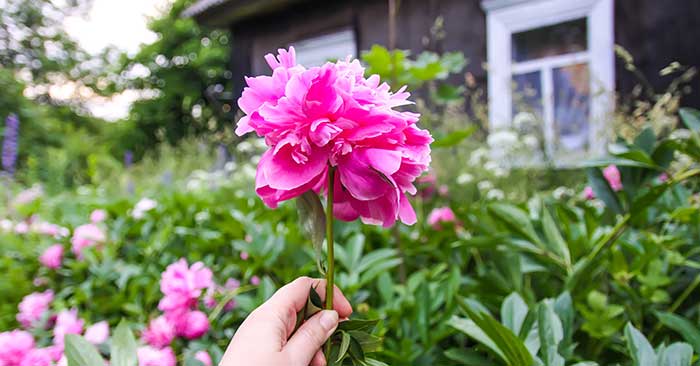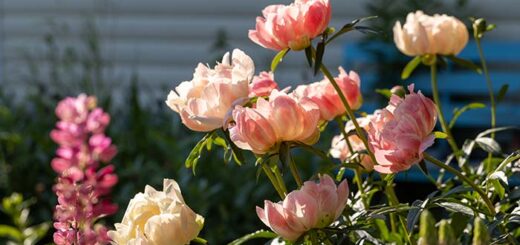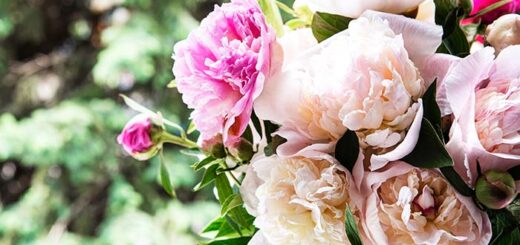Splitting Peonies in Spring
Splitting peonies in spring is a rewarding task that ensures your plants remain healthy and bloom beautifully yearly.
Spring is the perfect time to give your peonies a fresh start. After experimenting with splitting my peonies this season, I discovered how easy and beneficial it can be. Whether you want to rejuvenate an old plant or propagate new ones, splitting peonies will not only enhance your garden’s beauty but also infuse it with a new sense of vitality. Let’s dive into the step-by-step process to ensure your success.
Why Split Peonies?
Splitting or dividing peonies is essential for maintaining the health and vitality of your garden. Over time, peony plants can become crowded, and their growth can slow down, leading to fewer blooms and a less vibrant display. Splitting your peonies can rejuvenate older plants, propagate new ones, and ensure your garden remains lush and beautiful.
Benefits of Division
- Rejuvenating Old Plants:
- Peonies, especially herbaceous types, can become overgrown in the same spot after several years. Dividing them helps refresh the plant’s energy, promoting vigorous new growth and abundant flowers.
- Through my experiments, I’ve noticed that my older peonies, which were previously struggling, burst into life after being split and replanted.
- Increasing Bloom Production:
- Crowded peonies often produce fewer blooms. Splitting them gives each division more space and resources, leading to a more impressive floral display.
- After dividing my peonies, I observed a significant increase in blooms the following season, making the effort well worth it.
- Propagating New Plants:
- Splitting peonies is also an excellent way to propagate new plants from an existing one. This allows you to expand your garden without the additional cost of buying new plants.
- I created several new plants from a single mature plant, which I then shared with friends and family, spreading the joy of these beautiful flowers.

Image Source: Envato Elements
Signs That Your Peonies Need Splitting
- Reduced Flowering:
- If your peonies produce fewer flowers than they used to, consider dividing them. This is often a sign that the plant is becoming too crowded.
- When I noticed a decline in the blooms of my peonies, splitting them rejuvenated their flowering capacity.
- Crowded Growth:
- When peony clumps become too dense, the plants start competing for nutrients and water, resulting in poor overall health and growth.
- Splitting these crowded clumps allowed each division to thrive independently, leading to healthier plants.
When to Split Peonies
Choosing the right time to split your peonies is crucial for their survival and growth. The best time to divide peonies is in early spring before new growth appears or in late fall after the growing season has ended.
Ideal Timing
- Early Spring:
- Spring is an excellent time to split peonies because the plants are just beginning to wake up from their winter dormancy. The roots are still dormant, making it easier to handle them without causing too much stress.
- During my spring splits, I found the plants to recover quickly and start thriving as soon as the weather warmed up.
- Late Fall:
- Another good time to split peonies is in late fall after the foliage has died back but before the ground freezes. This timing allows the plants to establish roots before the winter and get a head start in the spring.
- My fall divisions also performed well, with the plants establishing themselves over the winter and showing robust growth in the spring.
Considerations Based on Climate and Plant Health
- Climate:
- If you live in a region with harsh winters, splitting your peonies in early spring is better to avoid exposing the newly divided roots to severe cold.
- Fall divisions are usually successful in milder climates, giving the plants enough time to settle in before the next growing season.
- Plant Health:
- Only split healthy peonies. Dividing a stressed or diseased plant can further weaken it. Ensure your plants are well-watered and free from any signs of distress before attempting to split them.
- I always check my peonies for signs of health, such as solid stems and vibrant leaves, before deciding to split them.
Tools and Preparation
Having the right tools and adequately preparing are essential for successfully splitting peonies. Proper preparation ensures the process is smooth and the plants can thrive after being divided.
Essential Tools
- Sharp Spade or Garden Fork:
- A sharp spade or garden fork is necessary for digging up the peony clump with minimal damage to the roots. Ensure your tools are clean and sharp to make the job easier.
- I always sharpen my spade before starting, which helps make clean cuts and reduces plant stress.
- Pruning Shears:
- Pruning shears help trim any damaged or excess foliage before replanting. Keeping the plant tidy helps it focus on root establishment.
- I use my shears to remove dead or damaged leaves, which helps the plant direct its energy to recovery and new growth.
- Clean Pots or Planting Beds:
- If you plan to pot your divisions or relocate them to new areas, ensure the pots or planting beds are clean and ready. This reduces the risk of disease and gives the plants a fresh start.
- I always complete the steps of preparing the pots with fresh soil and ensuring the planting beds are well-tilled and weed-free.
Pre-Splitting Preparations
- Watering the Plants:
- Water the peonies thoroughly a day before you plan to split them. This will help reduce shock and make the soil more manageable.
- I always find that well-hydrated plants are less stressed during the division process.
- Cleaning and Sterilizing Tools:
- Clean and sterilize your tools to prevent the spread of diseases. This is especially important if you are dealing with multiple plants.
- I soak my tools in water and bleach (1 part bleach to 9 parts water) for a few minutes before rinsing and drying them.
- Planning the New Locations:
- Plan where you will plant the new divisions. Ensure these spots have well-draining soil and receive adequate sunlight (at least 6 hours of direct sunlight daily).
- By pre-planning the planting spots, I ensure a smooth transition for the newly divided peonies, reducing the time they spend out of the ground.
Step-by-Step Guide to Splitting Peonies
Splitting peonies, also known as dividing peonies, is a straightforward process that can yield impressive results for your garden. Here’s a detailed, step-by-step guide to ensure you achieve the best outcomes.
1. Digging Up the Peony
Carefully Loosen the Soil:
- Begin by watering the area around the peony plant thoroughly a day before you plan to split it. This helps soften the soil, making it easier to dig up the plant without damaging the roots.
- Using a sharp spade or garden fork, gently loosen the soil around the base of the plant. Start digging at least 12 inches from the crown to avoid cutting into the roots.
Gently Lift the Root Ball:
- Once the soil is loosened, carefully lift the entire root ball from the ground. Take your time to ensure you don’t break or damage the roots.
- I always find digging around the plant in a circle helpful, gradually working my way inward until I can lift the root ball in one piece.
2. Dividing the Clump
Identify Natural Divisions:
- Examine the root ball to find natural divisions or clusters of eyes (the tiny, reddish buds where new growth will emerge). Each division should have at least 3-5 eyes and a good portion of healthy roots.
- My experience has shown that identifying these natural divisions simplifies and makes the splitting process more effective.
Use a Sharp Knife or Spade:
- Carefully cut through the root ball with a clean, sharp knife or spade to separate the divisions. You may need to make several cuts if the clump is huge.
- Ensure that each division has a good balance of roots and buds. This will help the new plants establish quickly and thrive.
Inspect and Trim the Divisions:
- After dividing the clump, inspect each section for damaged or diseased roots. Trim these away with pruning shears to prevent any issues from spreading.
- I always remove any broken or unhealthy roots, ensuring that each new plant has the best possible start.
3. Replanting the Divisions
Choose Suitable Locations:
- Select locations in your garden that offer well-draining soil and receive at least 6 hours of direct sunlight daily. Peonies thrive in sunny spots with rich, fertile soil.
- Planning the new planting sites helps make the transition smoother for the plants.
Plant at the Correct Depth:
- Dig a hole for each division that is deep enough to accommodate the roots without crowding them. The eyes should be planted about 1-2 inches below the soil surface.
- Planting too deep can hinder blooming while planting too shallow can expose the roots to the elements. Striking the right balance is crucial.
Water Thoroughly:
- After planting, water the divisions thoroughly to help settle the soil around the roots and reduce transplant shock. Keep the soil consistently moist but not waterlogged for the first few weeks.
- I ensure the soil is well-watered immediately after planting to help the new divisions establish quickly.
Post-Splitting Care
Proper aftercare is essential to help your newly divided peonies thrive. Here are some tips to ensure they get off to a strong start.
1. Immediate Aftercare
Mulching Around the Base:
- Apply a layer of mulch around the base of the newly planted divisions. Mulch helps retain moisture, regulate soil temperature, and suppress weeds.
- I prefer using organic mulch, such as straw or shredded leaves, which add nutrients to the soil as they decompose.
Regular Watering:
- Keep the soil around the new divisions consistently moist, especially during the first few weeks. Avoid overwatering, as this can lead to root rot.
- In my garden, I check the soil moisture regularly and water whenever the top inch feels dry.
2. Long-term Maintenance Tips
Fertilizing:
- Once the plants have established, usually after a few months, apply a balanced, slow-release fertilizer to promote healthy growth and blooming.
- I typically fertilize my peonies in early spring and again in late summer to ensure they have the nutrients they need for robust growth.
Monitoring for Pests and Diseases:
- Watch for common peony pests and diseases, such as botrytis blight, powdery mildew, and aphids. Regularly inspect your plants and take action at the first sign of trouble.
- Early intervention is key to preventing serious issues. Using natural remedies or appropriate treatments helps keep my peonies healthy.
Troubleshooting Common Issues
Even with the best care, you may encounter problems after splitting your peonies. Here are common issues and how to address them.
1. Problems to Watch For
Wilting or Yellowing Leaves:
- If the leaves of your newly divided peonies start to wilt or turn yellow, this could be a sign of transplant shock or root stress.
- Ensure the plants receive enough water, but not too much. Providing shade on the hottest day can also help reduce stress.
Poor Growth or Lack of Blooms:
- If your peonies are not growing well or fail to bloom, they might be planted too deep or too shallow. Improper planting depth can affect their ability to thrive.
- Check the planting depth and adjust if necessary. Also, make sure the plants are getting enough sunlight and nutrients.
2. Solutions and Preventive Measures
Addressing Transplant Shock:
- Transplant shock is common after dividing peonies. To minimize it, water the plants well and apply a light layer of mulch to maintain soil moisture.
- In my experience, providing consistent care and avoiding drastic changes in the plants’ environment helps them recover more quickly.
Improving Soil Conditions:
- If the soil is heavy or well-draining, it can help the growth of your peonies. To improve the soil’s structure and fertility, amend it with compost or organic matter.
- I’ve found that well-draining, nutrient-rich soil is key to peonies’ success. Regular soil testing and amendments can make a big difference.
Protecting Against Pests and Diseases:
- Regularly inspect your peonies for signs of pests and diseases. Use appropriate treatments, such as insecticidal soap for aphids or fungicides for fungal diseases.
- Practicing good garden hygiene, such as removing dead leaves and debris, helps prevent disease spread. I also rotate my plantings to reduce the risk of soil-borne issues.
My Final Thoughts
Splitting peonies in spring or even in late fall is a valuable gardening technique that can enhance the beauty and health of your garden. Through my experiments and experiences, I’ve found that dividing peonies rejuvenates older plants and allows for the propagation of new ones, enriching my garden year after year.
By following the right timing, using the proper tools, and preparing adequately, you can ensure a successful division process and enjoy healthier, more productive peony plants.
I hope to help you achieve the same rewarding results in your garden by sharing these detailed steps and insights. Your newly split peonies will thrive with patience and care, adding beauty and joy to your outdoor space.
FAQs about Splitting Peonies in Spring
Q: What is the best time to split peonies?
A: The best time to split peonies is in early spring before new growth appears or in late fall after the growing season has ended. Both timings allow the plants to recover and establish new roots effectively.
Q: How often should peonies be split?
A: Peonies should be split every 3-5 years. If you notice reduced flowering or overcrowded growth, it indicates that your peonies need to be divided.
Q: Can I split peonies in the summer?
A: Splitting peonies in the summer is not recommended as the plants are actively growing and may not recover well from the shock. Early spring or late fall is the preferred time for dividing peonies.
Q: How deep should I plant the peony divisions?
A: Plant the peony divisions with the eyes (buds) about 1-2 inches below the soil surface. Planting too deep can hinder blooming while planting too shallow can expose the roots.
Q: What type of soil is best for peonies?
A: Peonies thrive in well-draining, fertile soil with a slightly acidic to neutral pH (6.5-7.0). Amending the soil with compost or organic matter can improve its quality and drainage.
Q: How can I tell if my peonies need splitting?
A: Signs that peonies need splitting include reduced flowering, crowded growth, and a general decline in plant health. If your peonies look congested or are producing fewer blooms, it’s time to divide them.
Q: Should I fertilize peonies after splitting?
A: Yes, fertilizing peonies after splitting can help them recover and grow stronger. Use a balanced, slow-release fertilizer and apply it in early spring and late summer.
Q: What should I do if my newly split peonies are not blooming?
A: If newly split peonies are not blooming, check the planting depth and ensure they are not planted too deep. Also, make sure they are getting enough sunlight and nutrients. Sometimes, peonies take a season to recover and bloom after splitting.
Q: How do I prevent diseases when splitting peonies?
A: To prevent diseases, use clean, sterilized tools when splitting peonies. Remove any damaged or diseased roots before replanting. Good garden hygiene, such as cleaning up debris and dead leaves, also helps prevent disease from spreading.
Q: Can I split tree peonies the same way as herbaceous peonies?
A: No, tree peonies should not be divided like herbaceous peonies. Tree peonies are woody and do not respond well to division. Instead, they are propagated through grafting or from seed.
Q: How long does it take for split peonies to bloom?
A: After division, split peonies may take one to two growing seasons to bloom fully. This period allows them to establish their root systems and acclimate to their new environment.
Q: Is it necessary to mulch peonies after splitting?
A: Yes, mulching helps retain soil moisture, regulate temperature, and suppress weeds. Apply a layer of organic mulch around the base of the newly planted divisions.
Q: What should I do with the foliage after splitting peonies?
A: Trim any damaged or excess foliage to help the plant focus on root establishment. Healthy foliage can be left to support photosynthesis and plant growth.
Q: Can I use divided peonies to create a new peony bed?
A: Absolutely! Dividing peonies is a great way to propagate new plants and expand your garden. Ensure the new bed has well-draining soil and receives adequate sunlight.
References:
American Peony Society: “Peony Care” – Provides comprehensive guidance on the best practices for peony care, including when and how to divide them. Available at American Peony Society.
Royal Horticultural Society: “Dividing Herbaceous Perennials” – Offers detailed instructions on dividing peonies and other perennials, with specific advice on timing and technique. Available at Royal Horticultural Society.
University of Missouri Extension: “Peonies: Planting and Care” – Covers essential information on the care and maintenance of peonies, including the best times for division. Available at University of Missouri Extension.
Iowa State University Extension and Outreach: “Growing Peonies” – Discusses the ideal planting depth for peony divisions and other key factors for successful growth. Available at Iowa State University Extension and Outreach.
Penn State Extension: “Peony Growing Guide” – Explains soil requirements for peonies and how to amend soil to improve drainage and fertility. Available at Penn State Extension.


